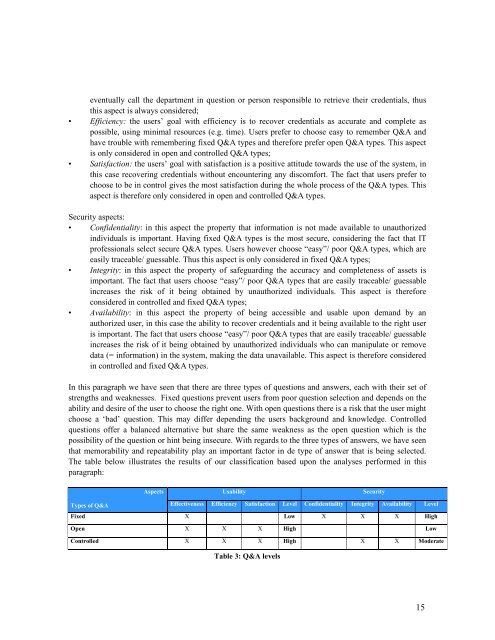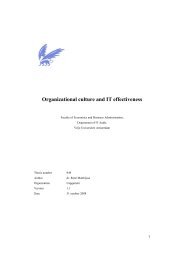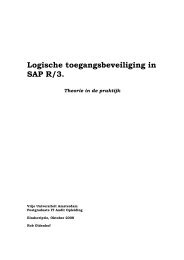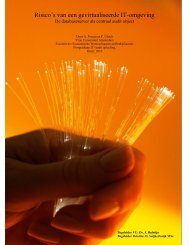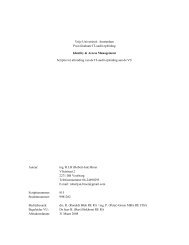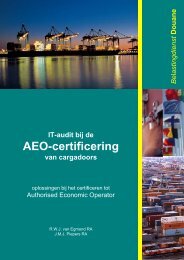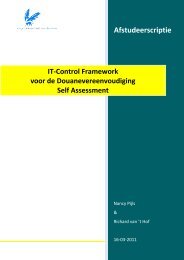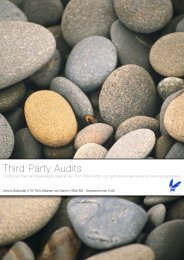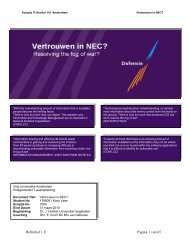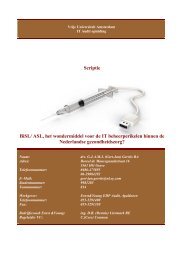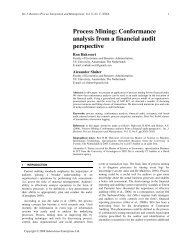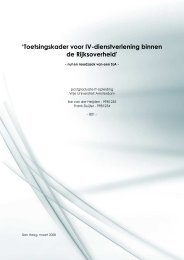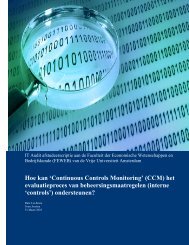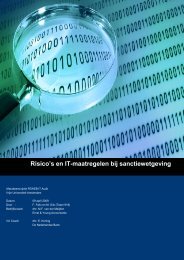Usability and Security
Usability and Security - Vurore
Usability and Security - Vurore
Create successful ePaper yourself
Turn your PDF publications into a flip-book with our unique Google optimized e-Paper software.
eventually call the department in question or person responsible to retrieve their credentials, thusthis aspect is always considered;• Efficiency: the users’ goal with efficiency is to recover credentials as accurate <strong>and</strong> complete aspossible, using minimal resources (e.g. time). Users prefer to choose easy to remember Q&A <strong>and</strong>have trouble with remembering fixed Q&A types <strong>and</strong> therefore prefer open Q&A types. This aspectis only considered in open <strong>and</strong> controlled Q&A types;• Satisfaction: the users’ goal with satisfaction is a positive attitude towards the use of the system, inthis case recovering credentials without encountering any discomfort. The fact that users prefer tochoose to be in control gives the most satisfaction during the whole process of the Q&A types. Thisaspect is therefore only considered in open <strong>and</strong> controlled Q&A types.<strong>Security</strong> aspects:• Confidentiality: in this aspect the property that information is not made available to unauthorizedindividuals is important. Having fixed Q&A types is the most secure, considering the fact that ITprofessionals select secure Q&A types. Users however choose “easy”/ poor Q&A types, which areeasily traceable/ guessable. Thus this aspect is only considered in fixed Q&A types;• Integrity: in this aspect the property of safeguarding the accuracy <strong>and</strong> completeness of assets isimportant. The fact that users choose “easy”/ poor Q&A types that are easily traceable/ guessableincreases the risk of it being obtained by unauthorized individuals. This aspect is thereforeconsidered in controlled <strong>and</strong> fixed Q&A types;• Availability: in this aspect the property of being accessible <strong>and</strong> usable upon dem<strong>and</strong> by anauthorized user, in this case the ability to recover credentials <strong>and</strong> it being available to the right useris important. The fact that users choose “easy”/ poor Q&A types that are easily traceable/ guessableincreases the risk of it being obtained by unauthorized individuals who can manipulate or removedata (= information) in the system, making the data unavailable. This aspect is therefore consideredin controlled <strong>and</strong> fixed Q&A types.In this paragraph we have seen that there are three types of questions <strong>and</strong> answers, each with their set ofstrengths <strong>and</strong> weaknesses. Fixed questions prevent users from poor question selection <strong>and</strong> depends on theability <strong>and</strong> desire of the user to choose the right one. With open questions there is a risk that the user mightchoose a ‘bad’ question. This may differ depending the users background <strong>and</strong> knowledge. Controlledquestions offer a balanced alternative but share the same weakness as the open question which is thepossibility of the question or hint being insecure. With regards to the three types of answers, we have seenthat memorability <strong>and</strong> repeatability play an important factor in de type of answer that is being selected.The table below illustrates the results of our classification based upon the analyses performed in thisparagraph:Aspects<strong>Usability</strong><strong>Security</strong>Types of Q&AEffectiveness Efficiency Satisfaction Level Confidentiality Integrity Availability LevelFixed X Low X X X HighOpen X X X High LowControlled X X X High X X ModerateTable 3: Q&A levels15


